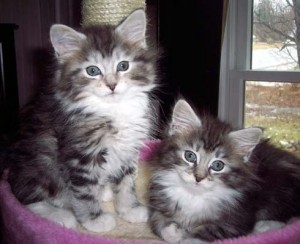Maine Coon Cat Breed Information

What Kind of Cat Breed is the Maine Coon Cat? The Main Coon Cat, is a long haired domestic cat breed which comes from Maine, USA.
History of the Maine Coon Cat:
There are many tales as to how the Maine Coon cat came to America.
Here are a few of these tales:
When Marie Antoinette tried to escape from France, she loaded her ship with some of her most beloved posetions, including six of her most beloved longhaired cats. Although she didn’t make it to America her cats did, landing on the Coast of Main where they mated with the Norwegian Forest cat and become today’s Maine Coon Cat.
Other people believe that the maine coon cats were brought over to America by Captain Charles Coon, an English seafarer who kept long-haired cats aboard his ships (probably to eat the mice that were always on ships in those days). Whenever Coon’s ship would anchor in US ports, the cats would exit the ship and mate with the local feral cats.
When long-haired kittens began appearing in the litters of the local cat population, they were referred to as one of “Coon’s cats”.
What is the Maine Coon Cat like?
The Main Coon cat is one of the biggest domestic cat breeds. The male maine coon cat weighs from 15 to 25 lb (6.8 to 11 kg) with females weighing from 10 to 15 lb (4.5 to 6.8 kg).
Adult Maine Coons vary between being 10 and 16 in (25 and 41 cm) long and they can reach a length of up to 40 in (100 cm), including the tail, which can reach a length of 14 in (36 cm).
The Main coons tail is long, soft and fluffy and heavily furred, almost resembling a raccoon’s tail.
The body is solid and muscular and the chest is broad.
Maine Coons take 3 to 5 years to reach their full adult size while other cat breeds take only a year.
This means they stay cute and small longer!

The Maine Coon’s fur is soft and silky with a lion-like ruff around the neck.
Although they are very hairy, you do not need to groom them too much as their coat is mostly self-maintaining due to a light-density undercoat.
In the winter their coat is thicker and thinner in the summer.
Maine Coon cats have larger claws than most other cats.
Maine Coons have several physical adaptations for survival in harsh winter climates. Their dense water-resistant fur is longer and shaggier on their underside and rear for extra protection when they are walking or sitting on top of wet surfaces of snow or ice.
Large paws, and especially the extra-large paws of polydactyl Maine Coons, facilitate walking on snow and are often compared to snowshoes.
Long tufts of fur growing between their toes help keep the toes warm and further aid walking on snow by giving the paws additional structure without significant extra weight.
Heavily furred ears with extra long tufts of fur growing from inside help keep their ears warm.
Maine Coon Cat Breed Temperament
Maine Coons are known as the “gentle giants” and are highly intelligent, making them easy to train. Some Maine Coon Breeders and cat owners say that their cat plays fetch and even learned how to do doggy tricks!
They are known for being loyal to their family, very loving yet also independent and not clingy.
The Maine Coon cat likes kids and dogs and cuddles!
They are playful all their lives long, the males tending to be more clownish and females generally possessing more dignity, yet both are equally affectionate.
Many Maine Coons have a fascination with water and love swimming and some theorize that this personality trait comes from their ancestors, who were aboard ships for much of their lives.
Looking to adopt a maine coon cat? Check out our FREE cat adoption classifieds!

I 100% agree with your information. I also bought a Pet Supplies with the help of the Barkbox Promo Code and this is the best way to buy a pet with a discount. Low prices are normally a real benefit of the e-commerce pet stores which carry pet supplies. Many times the prices are lower and even the quality is better from the online pet supplies shop. Local stores buy from different suppliers who offer discounts for larger orders. Small local stores cannot compete with the purchasing power of the larger nationwide chains. The pricing reflects this problem